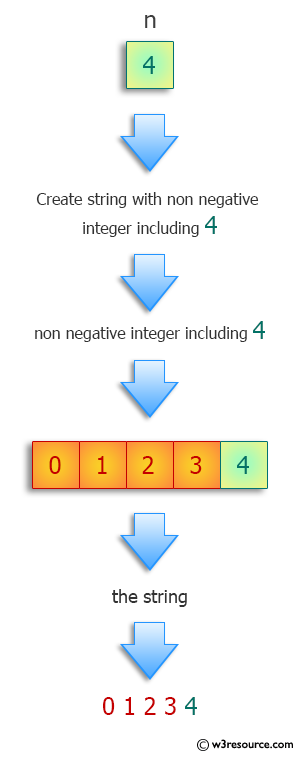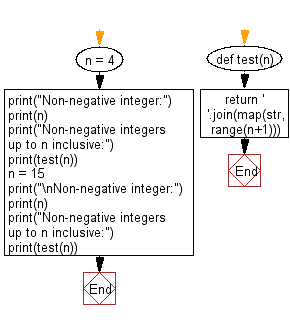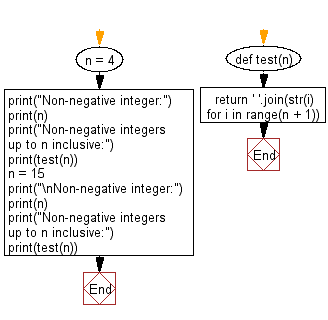Python: Find a string consisting of the non-negative integers up to n inclusive
Python Programming Puzzles: Exercise-17 with Solution
Write a Python program to create string consisting of the non-negative integers up to n inclusive.
Input: 4 Output: 0 1 2 3 4 Input: 15 Output: 0 1 2 3 4 5 6 7 8 9 10 11 12 13 14 15
Pictorial Presentation:

Sample Solution-1:
Python Code:
def test(n):
return ' '.join(map(str,range(n+1)))
n = 4
print("Non-negative integer:")
print(n)
print("Non-negative integers up to n inclusive:")
print(test(n))
n = 15
print("\nNon-negative integer:")
print(n)
print("Non-negative integers up to n inclusive:")
print(test(n))
Sample Output:
Non-negative integer: 4 Non-negative integers up to n inclusive: 0 1 2 3 4 Non-negative integer: 15 Non-negative integers up to n inclusive: 0 1 2 3 4 5 6 7 8 9 10 11 12 13 14 15
Flowchart:

Visualize Python code execution:
The following tool visualize what the computer is doing step-by-step as it executes the said program:
Sample Solution-2:
Python Code:
def test(n):
return ' '.join(str(i) for i in range(n + 1))
n = 4
print("Non-negative integer:")
print(n)
print("Non-negative integers up to n inclusive:")
print(test(n))
n = 15
print("\nNon-negative integer:")
print(n)
print("Non-negative integers up to n inclusive:")
print(test(n))
Sample Output:
Non-negative integer: 4 Non-negative integers up to n inclusive: 0 1 2 3 4 Non-negative integer: 15 Non-negative integers up to n inclusive: 0 1 2 3 4 5 6 7 8 9 10 11 12 13 14 15
Flowchart:

Visualize Python code execution:
The following tool visualize what the computer is doing step-by-step as it executes the said program:
Python Code Editor :
Have another way to solve this solution? Contribute your code (and comments) through Disqus.
Previous: Find the strings in a list containing a given substring.
Next: Find the indices of all occurrences of target in the uneven matrix.
What is the difficulty level of this exercise?
Test your Programming skills with w3resource's quiz.
Python: Tips of the Day
Find current directory and file's directory:
To get the full path to the directory a Python file is contained in, write this in that file:
import os dir_path = os.path.dirname(os.path.realpath(__file__))
(Note that the incantation above won't work if you've already used os.chdir() to change your current working directory, since the value of the __file__ constant is relative to the current working directory and is not changed by an os.chdir() call.)
To get the current working directory use
import os cwd = os.getcwd()
Documentation references for the modules, constants and functions used above:
- The os and os.path modules.
- The __file__ constant
- os.path.realpath(path) (returns "the canonical path of the specified filename, eliminating any symbolic links encountered in the path")
- os.path.dirname(path) (returns "the directory name of pathname path")
- os.getcwd() (returns "a string representing the current working directory")
- os.chdir(path) ("change the current working directory to path")
Ref: https://bit.ly/3fy0R6m
- New Content published on w3resource:
- HTML-CSS Practical: Exercises, Practice, Solution
- Java Regular Expression: Exercises, Practice, Solution
- Scala Programming Exercises, Practice, Solution
- Python Itertools exercises
- Python Numpy exercises
- Python GeoPy Package exercises
- Python Pandas exercises
- Python nltk exercises
- Python BeautifulSoup exercises
- Form Template
- Composer - PHP Package Manager
- PHPUnit - PHP Testing
- Laravel - PHP Framework
- Angular - JavaScript Framework
- Vue - JavaScript Framework
- Jest - JavaScript Testing Framework
